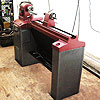I'm trying to finish up this chest or drawers for my son who's clothes are literally cascading out of his closet. I finally put the first bit of color on it yesterday, only to discover one of the side panels has cracked.
I thought I did everything right with this piece, but obviously I did something wrong. It's made of maple, the grain between the top and sides is oriented the same way, and the case is joined with Dominos.
The AC is on in the shop and it looks like the drop in humidity caused the side to shrink, but the top either hasn't shrunk to match or it's shrinking at a different rate.
Is there anything I can do to repair the crack? Any ideas on what I can do differently next time? It's really a bummer to be so close to finishing this and discovering this!







 Reply With Quote
Reply With Quote














